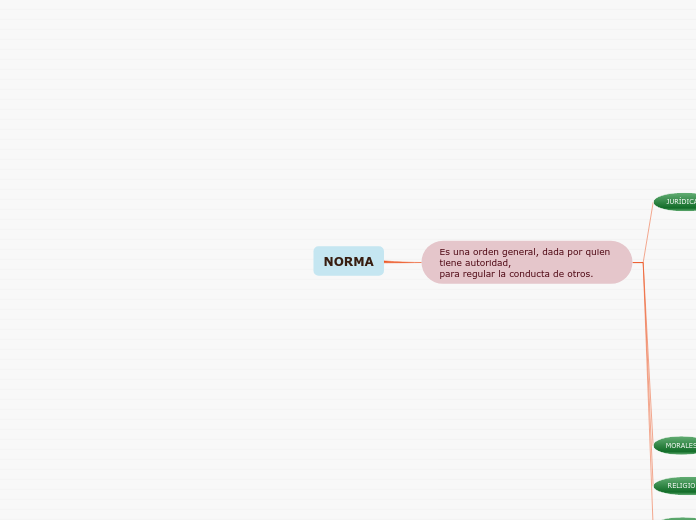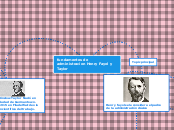NORMA
To name your story, you have to think about the overall message and what you want your audience to understand from the story. Also, make it relevant and easy to remember.
Es una orden general, dada por quien tiene autoridad,
para regular la conducta de otros.
The middle of the story is where you add layers of complications that will lead to the end. Reveal more about the character's journey. Did their personality go through changes? How did they overcome the challenges? And as you build up the story’s central conflict, make it more personal to that character. Also, from the middle act, you have to lead into the final act.
SOCIALES
Modales para la convivencia
civil. Regulan la convivencia de los individuos de una comunidad. Provienen del mutuo acuerdo y del consenso.
Ejemplo; 1) No masticar con la
boca abierta.
2) En nuestra sociedad todos deben
usar desodorante.
RELIGIOSAS
There wouldn't be any tension and excitement in your story if there weren't any obstacles in your character's way.
Los fundamentos de las
diferentes religiones. Afectan la vida espiritual de las personas, a través de la adhesión a un código o una filosofía considerada como camino hacia la salvación o la elevación.
A story is nothing more than a character overcoming a series of difficulties to reach the desired goal. Obstacles usually create suspense and conflict. In overcoming obstacles, there is growth: weak becomes strong; hatred turns into love; sadness into happiness; wrong into right; lies into truth; or evil becomes good.
See a few examples below:
- stopping a meteor
- finding a killer
- finding love
Ejemplo; 1) Ir a misa una vez
por semana.
2)No hacer actos que se consideren pecados.
MORALES
Your character(s) need(s) motivation in order to solve the challenge(s).
Aspirar a ser. Rigen el comportamiento de los individuos de una sociedad determinada, de acuerdo a lo que tradicionalmente ha entendido como “bueno”, “malo” o “adecuado”.
Why does your character need to confront this challenge? What does he/she expect to accomplish by solving it?
See a few examples:
- will marry in 3 days
- can fix the mistakes of the past
Ejemplo; 1)Ayudar a una persona
que lo necesite.
2)Ser honestos.
JURÍDICAS
Each story has a main character and that character usually needs to solve a problem or challenge. The character's challenge is the one that creates tension throughout the story.
Una norma jurídica es una regulación abstracta de conductas que se corresponde
con el siguiente esquema: supuesto de hecho / consecuencia jurídica.
Type in any other challenges which other characters in the story need to face.
Por ejemplo: si
matas (SH) / vas a la cárcel (CJ)
Normas de orden privado.
Aquellas que pueden ser más o menos elaboradas por los individuos, que rigen en silencio sus tratos y acuerdos, como los contratos.
Fuente: https://concepto.de/normas-juridicas/#ixzz6YsPJPt2D
Normas de orden público.
Nacidas del bien común y el interés colectivo, son generales y el individuo debe someterse a ellas, quiéralo o no.
Fuente: https://concepto.de/normas-juridicas/#ixzz6YsPCccq6
Normas de cambio
Que establecen el modo en que las normas jurídicas pueden derogarse total o parcialmente, cómo modificarlas o introducir nuevas.
Fuente: https://concepto.de/normas-juridicas/#ixzz6YsPA0Htr
Normas secundarias.
Que atribuyen poderes o facultades, atendiendo diferentes aspectos públicos y privados.
Fuente: https://concepto.de/normas-juridicas/#ixzz6YsP7EROqpic
Normas primarias.
Que regulan la conducta humana, prohibiendo, permitiendo y obligando.
Fuente: https://concepto.de/normas-juridicas/#ixzz6YsP4KfN7
Normas interpretativas
Aquellas que determinan o interpretan eventos o textos jurídicos tomando en consideración lo establecido por la Ley.
Fuente: https://concepto.de/normas-juridicas/#ixzz6YsP0vifj
Normas dispositivas.
Aquellas que obligan a un comportamiento determinado siempre y cuando no haya una voluntad expresa contraria
Fuente: https://concepto.de/normas-juridicas/#ixzz6YsOv69Du
Normas imperativas
Aquellas que obligan a un comportamiento determinado, sin importar la voluntad del individuo. Como las leyes penales.
Fuente: https://concepto.de/normas-juridicas/#ixzz6YsOrMIUZ










